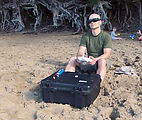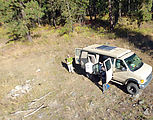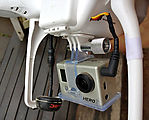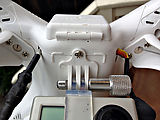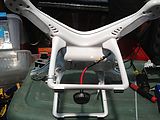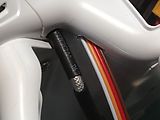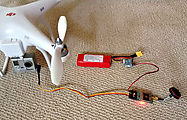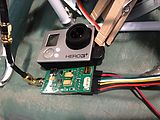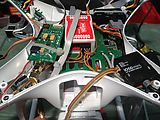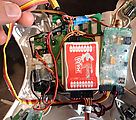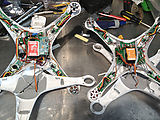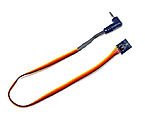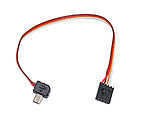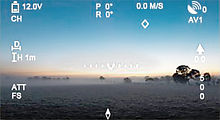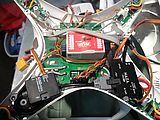FPV Video with FatShark
FPV Flying!
You can't help but look uber-geeky piloting this thing. But it's so much fun!
The FatShark Attitude SD transmits TV-quality video (mediocre). Higher resolution video would dramatically improve the immersive experience — as would a wider field of view. Someday...!
Though some people mount a tiny video camera to be the FPV "eyes", I find that the live video feed out of the GoPro camera works just fine.
The FatShark video is easily blocked by trees (because it is 5.8 GHz). A lower-frequency transmitter radio (such as 1 GHz or lower) would better allow use in vegetation.
Customizing the DJI Phantom
Here is what my DJI Phantom looks like holding a GoPro HERO2 camera. Two modifications you can see are the video cable (from the camera to the FatShark transmitter), and the FatShark transmitter "spironet" antenna. I put the holes in the Phantom's white plastic case at the seam where the battery door panel meets the main body. This way, I could make holes that were smaller than the cables' connector ends — there is no need to fish the cables through the holes.
Here I did the same thing on another DJI Phantom — this time with a longer antenna coax cable, and with a GoPro HERO3+ Black camera.
FatShark Attitude SD Video Transmitter
Here's the FatShark transmitter. The first photo shows it wired for testing before insertion into the DJI Phantom. It can use the GoPro camera as a video source. The next photo shows the inside of the DJI Phantom with the FatShark transmitter installed. The FatShark board looks corroded in these photos because it is: It survived a dip into the ocean — working again once dried! The last photo shows me transferring the FatShark from the water damaged quadcopter to a replacement one.
I don't know if it was necessary, but I decided to upgrade the stock FatShark antenna to a "spironet" antenna for potentially better range. I used a SMA right angle adapter to attach the antenna cable to the FatShark transmitter, and also a SMA coax extension cable to lower the antenna below the GoPro (in order to reduce interference).
GoPro Cable for Live Video Feed
The original GoPro cameras (HERO & HERO2) use a 2.5mm 4-conductor earphone-style connector for live video feed. This is the cable I used for my GoPro HERO2 camera: GoProHD Camera Cable (ImmersionRC/FatShark Style)
The newer GoPro cameras (HERO3, HERO3+, HERO4) have a USB interface for live video feed. One advantage is that you can power/charge your GoPro from your DJI Phantom while flying. This is the cable I use to connect my GoPro HERO3+ Black to the FatShark: RMRC GoPro HERO3/HERO3+/HERO4 Cable (ImmersionRC/FatShark Style) .
On Screen Display
I later added an on screen display. The DJI "iOSD Mini" overlays information (position, home direction, and various status items) on top of the live video before transmitting it to the FatShark goggles for viewing. To connect the DJI iOSD Mini to the DJI Phantom's NAZA controller, you need access to the "CAN bus". To do this, I used a DJI PMU-V2 , but apparently you can skip the PMU and with some soldering, directly connect to the DJI Phantom board's CAN bus . Below, you can see how I mounted the iOSD and PMU inside my Phantom, with plenty of room to spare — for the FatShark transmitter, etc.

